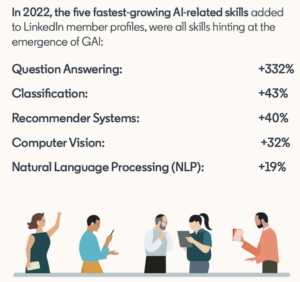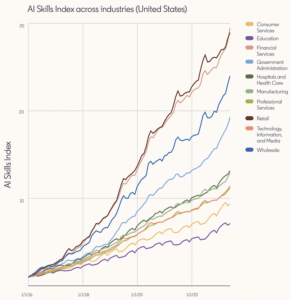Navigating the AI Skills Revolution in the Age of GenAI: LinkedIn Report

(Gorodenkoff/Shutterstock)
The launch of ChatGPT and similar generative AI technologies is reshaping the skills required in the workplace, according to a new report from LinkedIn.
“The Future of Work Report: AI at Work” found the pace at which LinkedIn members added AI skills to their profile has nearly doubled since ChatGPT’s debut in November 2022, rising from 7.7% (May–November 2022) to 13% (November 2022–June 2023).
LinkedIn says more of its members are adding AI skills to their profiles than ever before and that there has been a 21x increase in global English-language job postings that mention AI technology like ChatGPT since November 2022.
The five fastest-growing AI skills added to LinkedIn member profiles in 2022 were Question Answering (up 332%), Classification (up 43%), Recommender Systems (up 40%), Computer Vision (up 32%) and Natural Language Processing (up 19%), reflecting some of the most popular generative AI technologies in use today.
LinkedIn says an uptick in members’ skills, employers’ job postings, and platform conversations indicates that competition is intensifying to hire talent to fill specialized AI roles. Since generative AI is an emerging field, employers will need an increased emphasis on skills when hiring for AI roles. Companies will need to understand the skills they currently have and which ones are needed in order to hire the best candidates.
LinkedIn CEO Ryan Roslansky commented in the report that companies focusing on skills while shifting away from antiquated signals like degrees, pedigree, and workplace history will be able to ensure they hire the right people with the right skills. He also noted that it does not stop there, and that upskilling will be key: “Once you have those employees in the right roles with the right skills, it’s equally important to continue investing in their career progression and skills,” he said.
The report shows that in the U.S., the category of Technology, Information, and Media has the largest share of AI-skilled workers at 2.2%, and though this figure seems small, it is higher than that of other industries such as such as Education (1.2%), Professional Services (0.9%), Financial Services (0.9%), and Manufacturing (0.8%).
However, the speed at which LinkedIn members are adding AI skills to their profiles is increasing, with Financial Services at 30x, Retail at 29x, and Wholesale at 24x. Additionally, LinkedIn notes that Financial Services stands out as the only industry in which the share of members with AI skills and the speed at which they are adding AI skills to their profiles is above that of the average industry, showing how industries beyond Technology may have the potential to drive AI innovation.
Everyday jobs are being reshaped by generative AI capabilities as organizations incorporate tools like ChatGPT into daily operations. According to research from LinkedIn’s Economic Graph Research Institute, 84% of US members are in jobs that could leverage GAI to automate at least a quarter of repetitive tasks and increase productivity.
LinkedIn Chief Economist Karin Kimbrough says realizing the full potential of AI productivity gains depends on the diffusion of skills across geographies, industries, and talent.
“AI adoption and optimization of its use will of course take time, but at this early stage it appears that the pace of diffusion is getting underway. The brightest global economic outcome is one where innovation can scale borders and boost productivity growth for all,” she said in the report.
The rise of generative AI will also drive demand for people skills, the report found, as 92% of U.S. executives agree that people skills are more important than ever. People skills such as flexibility, professional ethics, social perception, and self-management have been the fastest growing in-demand skills since November 2022.
“Ultimately, when we talk about AI’s impact on work, what we are really talking about is how people will adopt these tools and continue to strengthen the people skills that complement them,” Kimbrough said.
This article first appeared on sister site Datanami.












